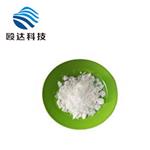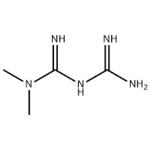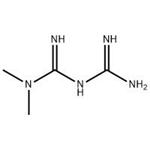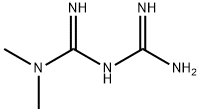Metformin
- CAS No.
- 657-24-9
- Chemical Name:
- Metformin
- Synonyms
- Metformine;METFORMIN BASE;dimethylbiguanide;nndg;dmgg;melbin;la6023;Fluamine;gliguanid;flumamine
- CBNumber:
- CB0506294
- Molecular Formula:
- C4H11N5
- Molecular Weight:
- 129.16
- MDL Number:
- MFCD00242652
- MOL File:
- 657-24-9.mol
- MSDS File:
- SDS
| Melting point | 199-200 °C |
|---|---|
| Boiling point | 229.23°C (rough estimate) |
| Density | 1.0743 (rough estimate) |
| refractive index | 1.5760 (estimate) |
| storage temp. | Keep in dark place,Inert atmosphere,Room temperature |
| solubility | Acetonitrile (Slightly), Aqueous Acid (Slightly), Dichloromethane (Slightly) |
| form | Solid |
| pka | pKa 2.8(H2O,t =32) (Uncertain) |
| color | White to Light Brown |
| Water Solubility | Water: 50 mg/mL (387.12 mM) |
| BCS Class | 3 |
| InChI | InChI=1S/C4H11N5/c1-9(2)4(7)8-3(5)6/h1-2H3,(H5,5,6,7,8) |
| InChIKey | XZWYZXLIPXDOLR-UHFFFAOYSA-N |
| SMILES | C(=N)(N(C)C)NC(=N)N |
| CAS DataBase Reference | 657-24-9(CAS DataBase Reference) |
| FDA UNII | 9100L32L2N |
| ATC code | A10BA02 |
| EPA Substance Registry System | Imidodicarbonimidic diamide, N,N-dimethyl- (657-24-9) |
SAFETY
Risk and Safety Statements
| Symbol(GHS) |  GHS07 |
|---|---|
| Signal word | Warning |
| Hazard statements | H302 |
| Precautionary statements | P264-P270-P301+P312-P330-P501 |
| Toxicity | LD50 oral in mouse: 1450mg/kg |
Metformin price More Price(6)
| Manufacturer | Product number | Product description | CAS number | Packaging | Price | Updated | Buy |
|---|---|---|---|---|---|---|---|
| TRC | M258858 | Metformin | 657-24-9 | 50mg | $100 | 2021-12-16 | Buy |
| ChemScene | CS-0009563 | Metformin ≥98.0% | 657-24-9 | 5g | $113 | 2021-12-16 | Buy |
| Medical Isotopes, Inc. | 5808 | Metformin | 657-24-9 | 10mg | $190 | 2021-12-16 | Buy |
| American Custom Chemicals Corporation | API0003317 | Metformin 95.00% | 657-24-9 | 1G | $681.08 | 2021-12-16 | Buy |
| Crysdot | CD13007301 | N,N-Dimethylimidodicarbonimidicdiamide 95+% | 657-24-9 | 10g | $225 | 2021-12-16 | Buy |
Metformin Chemical Properties,Uses,Production
Description
The study of metformin and its hypoglycemic effects originated from the study of goat’s rue plants, also known as Galega officinalis(French lilac). Goat’s rues are native plants in the Middle East and introduced to Europe later and have been used as forage and ornamental plants throughout the world, including China. As early as in the Middle Ages in Europe, it was found that goat’s rues could ease polyuria, which is one of the typical symptoms of diabetes. While goat’s rues were used to treat a variety of other diseases in the Middle Ages, it was found to cause poisoning symptoms in livestock. Goat’s rues are still used as medical plants at present, mainly for diabetes, diuretic, hepatoprotection, aiding in digestion and promoting lactation, etc. In China, goat’s rues were recorded first in the dictionary of Chinese seed plants and mainly used for the treatment of diabetes. However, because of high toxicity, it is rarely used in traditional Chinese medicines at present.
Physical properties
Appearance: white crystalline or crystalline powder, odorless. Solubility: freely soluble in water, soluble in methanol, slightly soluble in ethanol, and insoluble in chloroform or ether. Melting point: 223–226°C.
Originator
Diabetex ,Germania
History
Metformin is a biguanide compound which originated from the extraction of goat’s
rue plants. The structure of metformin was identified by British scholars in the early
1920s. In 1922, Werner and Bell et?al. first synthesized metformin in 31 institutes in
Dublin, Ireland. In 1929, Slotta and Tschesche found metformin’s hypoglycemic action. However, because of other potent antidiabetic drugs such as insulin
which were widely used in clinical practice, the pharmacological effects of metformin didn’t receive much attention.
Until the 1950s, a French diabetic scientist Jean Sterne found the hypoglycemic
effect of metformin through the study of galegine. Then the drug was used in diabetic patients for the first time, and the results were published in 1957. UKPDS, which began from 1977 and ended in 1997 and
was then followed up for 10?years, is the longest in the history of clinical trials and
has a significant impact on practice and guidelines for prevention and treatment of
diabetes mellitus. In this trial, metformin was found to reduce the risk of diabetic
complications by 32%. In addition, it was proved for the first time that metformin
can reduce blood glucose and protect against cardiovascular function, especially in
obese patients. In 1994, metformin was approved by the US FDA for type 2
diabetes treatment. Currently, metformin has become the world’s most widely used
antidiabetic drug.
Aiming at improving the stability of the absorption of metformin, chemists have
also carried out a series of structural renovation and modification. Metformin activates with carbonyl, esters, chlorides, and aldehydes to form triazine compounds,
with 1,3-diketone to produce pyrimidine compounds, and with disulfides to produce
C-S coupling products, etc.
Uses
non-insulin dependent diabetes mellitus
Definition
ChEBI: Metformin is a member of the class of guanidines that is biguanide the carrying two methyl substituents at position 1. It has a role as a hypoglycemic agent, a xenobiotic, an environmental contaminant and a geroprotector. It is functionally related to a biguanide. It is a conjugate base of a metformin(1+).
Indications
Metformin (Glucophage) was used in Europe for many years before it was approved for use in the United States in 1995. Metformin is the only approved biguanide for the treatment of patients with NIDDM that are refractory to dietary management alone. Metformin does not affect insulin secretion but requires the presence of insulin to be effective. The exact mechanism of metformin’s action is not clear, but it does decrease hepatic glucose production and increase peripheral glucose uptake. When used as monotherapy, metformin rarely causes hypoglycemia.
Manufacturing Process
The boiling mixture of 1,000 L xylene, 450 kg dimethylamine and 840 kg dicyanamide was added 365 kg hydrogene chloride. Yield of biguanide, 1,1- dimethyl-, hydrochloride 1,588 kg (96%). Biguanide, 1,1-dimethyl-, hydrochloride may be recrystallysed from methanol.
Therapeutic Function
Oral hypoglycemic
Biological Functions
Metformin can lower free fatty acid concentrations by 10 to 30%. This antilipolytic effect may help to explain the reduction in gluconeogenesis through reduced levels of available substrate (65). When given as a monotherapy, metformin treatment does not lead to hypoglycemia, so it is better described as an antihyperglycemic agent rather than a hypoglycemic agent.
General Description
Metformin, N,N-dimethylimidodicarbonimidicdiamide hydrochloride (Glucophage), is a bisguanidine.This class of agents is capable of reducing sugar absorptionfrom the gastrointestinal tract. Also, they can decrease gluconeogenesiswhile increasing glucose uptake by muscles andfat cells. These effects, in turn, lead to lower blood glucoselevels. Unlike the sulfonylureas, these are not hypoglycemicagents but rather can act as antihyperglycemics. This differencein nomenclature is caused by the inability of these agentsto stimulate the release of insulin from the pancreas. Often,metformin is coadministered with the nonsulfonylureas to improvethe efficacy of those agents.
Mechanism of action
The mechanism of action of biguanides is still not fully understood. Three major tissues have been identified as pharmacological sites of action: (1) the small intestinal wall, (2) the liver, and (3) peripheral tissues, mainly the skeletal muscle: 1. For the small intestine an inhibition of glucose absorption was described, however, this is, at least for metformin, of minor significance and not important for the blood glucose lowering effect. However, the intestinal glucose metabolization to lactate is stimulated and reduces the postprandial uptake of glucose by the liver. 2. Numerous studies have shown that biguanides inhibit hepatic gluconeogenesis and this may contribute to the blood glucose lowering effect, particularly in the fasting state. Again, metformin has probably less impact on gluconeogenesis than phenformin and buformin. 3. In the peripheral tissues, metformin increases the glucose disposal and utilization particularly in the skeletal muscle, which is probably the major contribution to the blood glucose lowering activity. In vitro studies using cell cultures have shown that metformin potentiates insulin action. In vivo studies in animals and diabetic patients have demonstrated that metformin reduces insulin resistance, at least in obese individuals.
Pharmacology
As a traditional antidiabetic drug, metformin can reduce the levels of blood glucose and lipid, as well as regulating cell growth, anti-inflammation, antiaging, etc. The main pharmacological mechanisms are inhibition of hepatic gluconeogenesis, the activation of AMP-activated protein kinase (AMPK), and the regulation of mitochondrial function.
Improvement of Insulin Resistance and Decrease of Blood Glucose Levels
The main pharmacological effects of biguanide drugs are to reduce blood glucose output and improve peripheral insulin resistance. Metformin inhibits hyperglycemia mainly by inhibiting hepatic glucose production (hepatic gluconeogenesis), increasing muscle glucose uptake.
Regulation of Lipid Metabolism and Reducing Body Weight
Metformin can reduce the blood triglycerides in circulation, improve liver steatosis, promote the oxidation of brown adipose tissue and VLDL-fatty acid triglyceride uptake, and inhibit fat formation; the process may be related with the activation of AMPK. AMPK can phosphorylate acetyl coenzyme A carboxylase (ACC) and inhibit the conversion of acetyl coenzyme A into malonyl-CoA. Malonyl-CoA is a precursor of fatty acid production and is an allosteric inhibitor of fatty acid transporting to mitochondria.
Prevention and Treatment of Tumors
Epidemiological studies have shown that metformin reduced the risk of multiple types of tumors in type 2 diabetes and nondiabetes patients and reduced tumor-related mortality. Metformin also has a therapeutic effect on various tumors. The antitumor effect of metformin may be through the reduction of serum insulin and insulin-like growth factor-1 (IGF-1) levels or activation of LKB1/AMPK, thereby blocking the mammalian target of rapamycin-sensitive complex 1 (mTORC1) signaling pathway.
Antiaging Antiaging effect is a major discovery in the new role of metformin. FDA approved the phase 4 of clinical trial of metformin for antiaging effect, and the trial is ongoing. The study suggests that the antiaging effect of metformin is closely related to the mitochondria, through the regulation of mitochondrial function to activate AMPK and inhibit mTOR, thereby reducing energy consumption. Furthermore, metformin can regulate oxidative stress, reduce tissue inflammation, and reduce the growth factor level and cell proliferation. The above effects and the combinational effect result in the improvement of health and achieving longevity.
Other Effects Studies have shown that metformin helps to prevent type 2 diabetes. For young people with a high body mass index, metformin is more effective than lifestyle control.
In addition, metformin can improve and prevent vascular disease, improve mitochondrial function, and serve as anti-inflammatory agent and antioxidant.
Metformin is hydrophilic and distributed in tissues in an active manner. After
oral administration, metformin is absorbed quickly and rapidly distributed into various tissues, mainly in the liver, gastrointestinal tract, and kidney.
Clinical Use
Metformin works best in patients with significant hyperglycemia and is often considered first-line therapy in the treatment of mild to moderate type II overweight diabetics who demonstrate insulin resistance. The United Kingdom Prospective Diabetes Study demonstrated a marked reduction in cardiovascular comorbidities and diabetic complications in metformintreated individuals. Metformin has also been used to treat hirsutism in individuals with polycystic ovarian syndrome and may enhance fertility in these women, perhaps by decreasing androgen levels and enhancing insulin sensitivity.
Safety Profile
Poison by subcutaneous and intraperitoneal routes. Mildly toxic by parenteral route. Experimental teratogenic effects. Mutation data reported. When heated to decomposition it emits toxic fumes of NOx
Metabolism
Metformin is quickly absorbed from the small intestine. Bioavailability is from 50 to 60%, and the drug is not protein bound. Peak plasma concentrations occur at approximately 2 hours. The drug is widely distributed in the body and accumulates in the wall of the small intestine. This depot of drug serves to maintain plasma concentrations. Metformin is excreted in the urine, via tubular excretion, as unmetabolized drug with a half-life of approximately 2 to 5 hours; therefore, renal impairment as well as hepatic disease are contraindications for the drug.
Metformin Preparation Products And Raw materials
Raw materials
Preparation Products
| Supplier | Tel | Country | ProdList | Advantage | |
|---|---|---|---|---|---|
| Wuhan senwayer century chemical Co.,Ltd | +undefined-27-86652399 +undefined13627115097 | market02@senwayer.com | China | 874 | 58 |
| Shanghai Medfine Bio-pharmaceutical Co., Ltd | +8613100311300 | tina.lv@bio-medfine.com | China | 202 | 58 |
| Guangzhou Tengyue Chemical Co., Ltd. | +86-86-18148706580 +8618826483838 | evan@tyvovo.com | China | 152 | 58 |
| Henan Fengda Chemical Co., Ltd | +86-371-86557731 +86-13613820652 | info@fdachem.com | China | 7845 | 58 |
| Shanghai Affida new material science and technology center | +undefined15081010295 | 2691956269@qq.com | China | 359 | 58 |
| Henan Tianfu Chemical Co.,Ltd. | +86-0371-55170693 +86-19937530512 | info@tianfuchem.com | China | 21691 | 55 |
| Hubei Jusheng Technology Co.,Ltd. | 18871490254 | linda@hubeijusheng.com | CHINA | 28180 | 58 |
| Hubei xin bonus chemical co. LTD | 86-13657291602 | linda@hubeijusheng.com | CHINA | 22968 | 58 |
| Shandong chuangyingchemical Co., Ltd. | 18853181302 | sale@chuangyingchem.com | CHINA | 5909 | 58 |
| Shenzhen Excellent Biotech Co., Ltd. | 13480692018 | ramyan@ex-biotech.com | CHINA | 954 | 58 |
Related articles
- New Study Reveals Genetic Polymorphisms Affecting Metformin Efficacy
- Metformin's pharmacokinetics involve active cellular uptake through transporters. Genetic polymorphisms in cation transporters....
- Dec 27,2023
- Metformin: Activity, Pharmacodynamics, Mechanisms and Application Studies
- The metformin is biguanide containing two coupled molecules of guanidine with additional substitutions. It has been widely use....
- Mar 3,2023
View Lastest Price from Metformin manufacturers
| Image | Update time | Product | Price | Min. Order | Purity | Supply Ability | Manufacturer | |
|---|---|---|---|---|---|---|---|---|
 |
2024-04-25 | Metformin
657-24-9
|
US $0.00-0.00 / KG | 1KG | 99 | 50000KG/month | Shanghai Affida new material science and technology center | |
 |
2024-04-05 | Metformin
657-24-9
|
US $8.00-1.00 / kg | 1kg | 99% | g-kg-tons, free sample is available | Henan Fengda Chemical Co., Ltd | |
 |
2023-11-27 | Metformin
657-24-9
|
US $75.00 / kg | 1kg | 99% min | 20 tons | Wuhan Senwayer Century Chemical Co.,Ltd |







